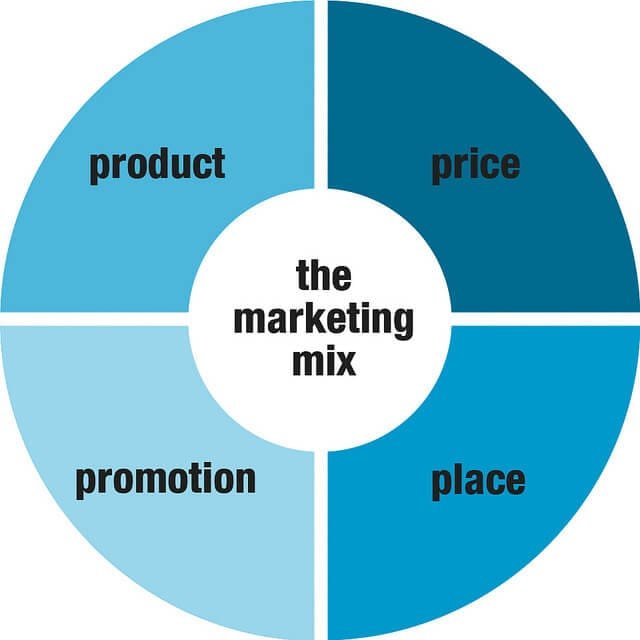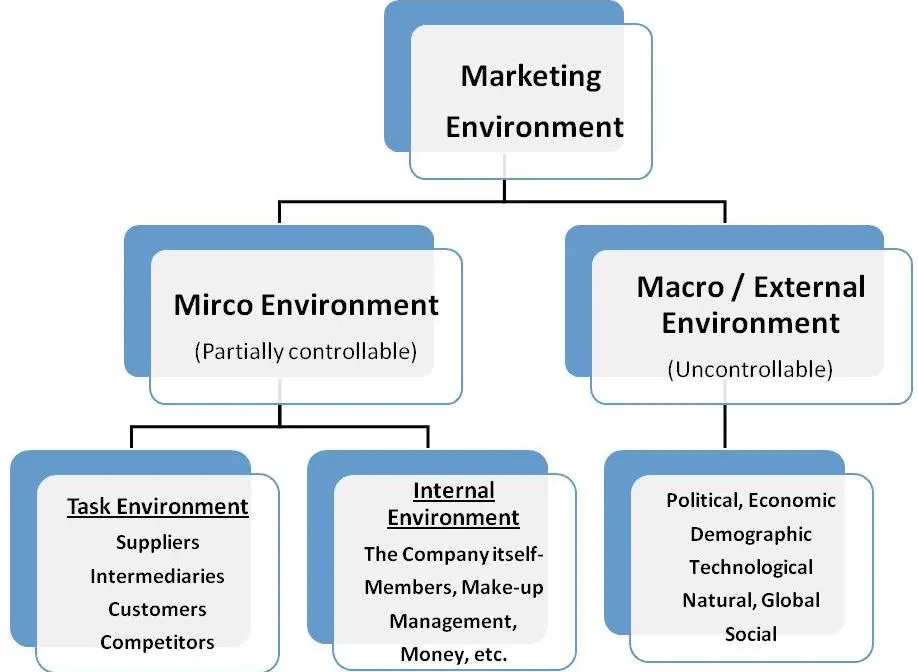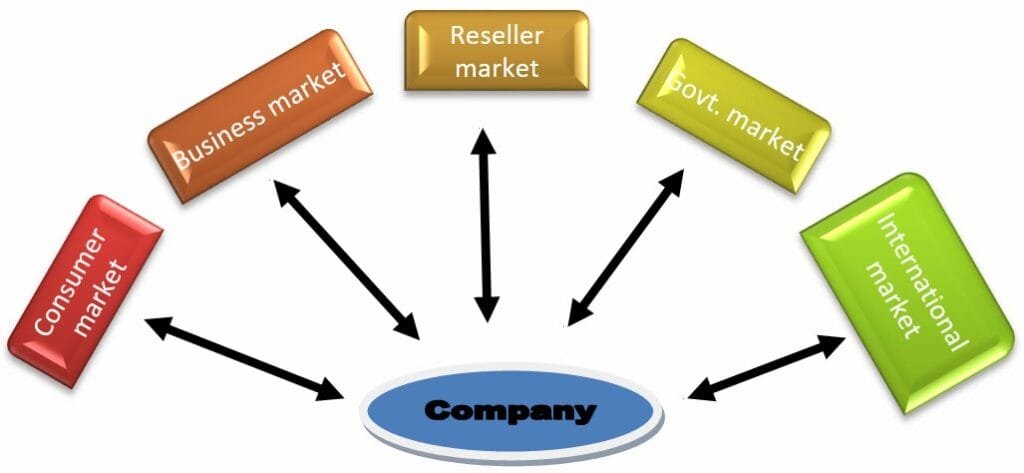The marketing mix, commonly referred to as the 4Ps, serves as a strategic framework that assists businesses in formulating and implementing effective marketing strategies. It comprises four fundamental elements: Product, Price, Place, and Promotion. While these components are relevant to both products and services, their application may vary slightly.
Table of Contents
Components of the Marketing Mix for Products and Services

Product
Definition: The product encompasses the actual goods or services that a business provides to fulfill the needs or wants of its customers. This includes both tangible items, such as electronics or apparel, and intangible services, such as financial services or consulting.
For Products: The product aspect emphasizes the physical characteristics of the item, including design, features, quality, branding, and packaging. It is vital to deliver a product that aligns with customer expectations and differentiates itself in the marketplace.
For Services: In the context of services, the product aspect highlights features such as reliability, responsiveness, customer experience, and customization. Given the intangible nature of services, it is essential to cultivate a perception of value and trust among customers.
Price
Definition: Price refers to the monetary amount that customers are required to pay in order to obtain a product or service. It stands as one of the most significant elements influencing consumer purchasing decisions.
For Products: Pricing strategies for products encompass cost-based pricing, value-based pricing, and competition-based pricing. The established price should accurately represent the perceived value of the product, its production expenses, and the prevailing competitive environment.
For Services: Service pricing may involve hourly charges, subscription models, or fixed fees, contingent upon the nature of the service provided. The perceived value and quality of the service play a crucial role in determining the price customers are prepared to pay.
Distribution
Definition: Distribution pertains to the pathways through which a product or service is delivered to the consumer. It encompasses the logistics of making the product available to the clientele.
For Products: In the case of tangible goods, distribution entails strategic choices regarding retail locations, wholesalers, e-commerce platforms, and the management of the supply chain. The objective is to guarantee that the product is readily accessible to the intended audience.
For Services: When it comes to services, distribution typically denotes the venue where the service is rendered, which may be a physical site (such as a restaurant or spa) or a digital platform (such as online consultations or e-learning). Key factors include accessibility and convenience.
Promotion
Definition: Promotion encompasses the various strategies employed to convey the advantages of a product and encourage consumer purchases. This includes advertising, public relations, sales promotions, and personal selling.
For Products: Promotional activities for products involve advertising campaigns, discounts, special offers, in-store promotions, and product demonstrations. It is essential to emphasize the product’s features, benefits, and unique selling points.
For Services: The promotion of services typically centers on establishing trust and credibility. This may involve customer testimonials, case studies, free trials, and the presentation of service guarantees. Additionally, digital marketing platforms, such as social media, are extensively utilized to enhance visibility and attract potential customers.
Marketing Environment: Meaning and Scope
The marketing environment encompasses the various external and internal factors that affect an organization’s capacity to cultivate and sustain effective relationships with its target audience. It comprises all elements that influence marketing decisions, including economic conditions, technological innovations, social and cultural dynamics, legal frameworks, and competitive actions. A comprehensive understanding of the marketing environment enables businesses to recognize potential opportunities and threats, thereby facilitating the adaptation of their strategies.
Meaning of Marketing Environment

The marketing environment consists of both the internal factors (within the organization) and the external factors (outside the organization).
Internal Factors
These are elements that reside within the organization, such as its resources, capabilities, organizational culture, marketing strategies, and structural framework. The internal environment is manageable by the organization, and the decisions made internally can significantly influence the overall marketing approach.
External Factors
The external environment comprises elements that lie beyond the organization’s control. These factors impact the company’s operations and include both the micro-environment and macro-environment.
- Micro-environment: This pertains to the immediate surroundings in which a company functions, including suppliers, customers, competitors, distributors, and other relevant stakeholders.
- Macro-environment: This refers to the wider societal influences that can impact the business, encompassing economic, technological, political, social, cultural, and legal factors, often referred to collectively as PESTLE.
Scope of Marketing Environment

The marketing environment encompasses a wide range of critical factors that significantly influence a company’s marketing strategies:
Economic Factors: Economic conditions, including inflation rates, income levels, employment statistics, and consumer spending habits, directly affect the marketing of products and services. For instance, during economic downturns, businesses may need to revise their pricing and promotional approaches to sustain sales.
Technological Factors: Advancements in technology create new avenues for product development, marketing strategies, and customer engagement. The emergence of social media and digital marketing platforms, for example, has transformed how businesses interact with their clientele.
Social and Cultural Factors: Social and cultural dynamics, including demographic changes, cultural movements, and societal values, influence consumer preferences and behaviors. It is crucial for businesses to comprehend these elements to effectively customize their products, advertising, and communication methods to align with customer expectations.
Political and Legal Factors: Government regulations, policies, laws, and the overall political climate significantly impact marketing strategies. Businesses must navigate legal constraints related to advertising, consumer protection, and industry-specific regulations when formulating their marketing initiatives.
Competitive Factors: Understanding the competitive landscape is essential, as it involves analyzing competitors’ strategies, strengths, weaknesses, and market positions. Companies must consistently observe competitor activities and adapt their marketing strategies to either maintain or enhance their market presence.
Natural Factors: Environmental considerations, such as natural disasters, climate change, and the availability of resources, can influence business operations and marketing approaches. Increasing awareness of sustainability issues has prompted many organizations to implement eco-friendly marketing strategies.
Microenvironment Variables
The microenvironment encompasses the elements within a company’s immediate surroundings that influence its capacity to serve customers and engage with stakeholders. These factors are generally within the company’s control or influence, although they may still be impacted by external conditions. Significant microenvironment factors include:
Customers
Customers represent the primary focus of all marketing efforts. Gaining insight into their needs, preferences, and behaviors is vital for crafting effective marketing strategies. Companies must remain attuned to customer demands to customize their products, services, and communications accordingly.
Suppliers
Suppliers are responsible for providing the essential raw materials, components, or services required for a business to manufacture its offerings. The dependability, cost, and quality of suppliers significantly impact a company’s ability to deliver products punctually and uphold the desired quality standards.
Competitors
Competitors consist of other enterprises that offer similar products or services. The competitive landscape shapes pricing strategies, product characteristics, and promotional approaches. Companies must evaluate the strengths, weaknesses, opportunities, and threats posed by competitors to effectively position themselves in the marketplace.
Intermediaries (Distributors)
Intermediaries, including wholesalers, retailers, agents, and distributors, facilitate the movement of products from the company to the final consumer. These partners are crucial in the realms of product distribution, marketing communication, and sales processes. A company’s interactions with intermediaries can significantly influence its market reach and sales outcomes.
Publics
Publics are groups that hold an actual or potential interest in the company. They may be internal (such as employees and shareholders) or external (including media, government entities, and local communities). Effectively managing relationships with diverse publics is essential for sustaining a favorable brand image and reputation.
Company
The company itself constitutes a component of the microenvironment. Its organizational structure, culture, internal resources, and overall capabilities play a critical role in shaping its operational effectiveness.
Macroenvironment Variables
The macroenvironment encompasses the extensive external elements that influence all organizations within a particular market or industry. These elements are primarily outside the control of individual companies and play a crucial role in shaping their operational and marketing strategies. The principal macroenvironment variables consist of:
Economic Environment
Economic conditions, including inflation rates, recessions, income distribution, and consumer expenditure trends, have a profound impact on the behavior of both consumers and businesses. For instance, during economic downturns, consumers tend to curtail their spending, which subsequently affects the demand for various products and services.
Technological Environment
Advancements in technology can create new avenues for innovation and operational efficiency, yet they may also present challenges for companies that do not adapt accordingly. Technological shifts can influence product development, marketing techniques, and customer interaction. The emergence of digital technologies, such as the internet and mobile platforms, has notably transformed marketing approaches.
Political and Legal Environment
The framework of government policies, regulations, and laws significantly affects business operations. This encompasses aspects such as taxation, trade limitations, advertising standards, consumer protection legislation, and environmental laws. Additionally, the degree of political stability can impact the confidence levels of businesses and investors.
Social and Cultural Environment
Social and cultural dynamics, including demographic trends, lifestyle choices, values, and attitudes, play a vital role in shaping consumer behavior. A comprehensive understanding of these factors enables businesses to customize their products, services, and marketing strategies to better meet customer expectations. For example, shifts in family dynamics or cultural values can unveil new market opportunities.
Environmental (Natural) Factors
The natural environment pertains to elements associated with the availability of natural resources, climatic conditions, and sustainability practices. Challenges such as climate change, resource scarcity, and environmental conservation can significantly affect product development and manufacturing processes.
Reactive and Proactive marketing
Reactive Marketing
Reactive marketing refers to a strategy in which businesses adjust their actions in response to shifts in the market, alterations in customer behavior, or the actions of competitors after these events have occurred. This approach emphasizes the need to tackle immediate challenges or seize opportunities as they present themselves.
Characteristics of Reactive Marketing
- Response-oriented: The strategy is formulated as a reaction to external circumstances.
- Short-term orientation: It seeks to resolve pressing issues or take advantage of fleeting opportunities.
- Customer-focused: Often triggered by customer feedback, complaints, or observable trends in behavior.
- Risk management: It aims to lessen the effects of unforeseen market fluctuations.
Examples:
- A business reducing prices to align with a competitor’s promotional offer.
- Introducing a product revision following unfavorable customer feedback.
- Developing a marketing initiative in reaction to a popular social or cultural phenomenon.
Advantages of Reactive Marketing
- Swift adaptation to changes in the market landscape.
- Cost-efficient in addressing specific, immediate challenges.
- A customer-centric approach that caters to real-time demands.
Disadvantages of Reactive Marketing
- Potential to overlook opportunities for sustainable growth.
- Risk of being viewed as reactive rather than innovative.
- May lead to a deficiency in long-term strategic direction.
Proactive Marketing
Proactive marketing refers to the practice of anticipating future market dynamics, customer preferences, or competitor actions and formulating strategies in advance to effectively respond to these changes. It prioritizes innovation and strategic foresight.
Characteristics of Proactive Marketing
- Future-oriented: Concentrates on forecasting and influencing market conditions.
- Long-term perspective: Seeks to establish enduring competitive advantages.
- Innovation-centric: Frequently entails the development of new products, services, or marketing initiatives.
- Strategic analysis: Involves comprehensive market research and analysis to predict trends.
Examples:
- Launching an innovative product ahead of competitors.
- Crafting a marketing strategy for an upcoming event, such as a holiday season or significant sporting occasion.
- Investing in new technologies or platforms to attract emerging customer demographics.
Advantages of Proactive Marketing
- Establishes the company as a leader in the market.
- Enhances brand reputation and fosters customer loyalty.
- Offers a competitive advantage by remaining ahead of market trends.
Disadvantages of Proactive Marketing
- Necessitates substantial investment in research and development.
- Carries a higher risk of failure if forecasts prove to be incorrect.
- May require a longer timeframe to yield measurable outcomes.
Marketing Environment in Nepal
The marketing environment in Nepal is influenced by a combination of internal and external factors that affect the operational effectiveness of businesses within the country. The distinct socio-economic, cultural, and geographical characteristics of Nepal present both opportunities and challenges for marketers. A comprehensive understanding of this environment is essential for businesses to tailor their strategies and fulfill consumer demands.
Microenvironment in Nepal
The microenvironment encompasses elements that are in close proximity to the business and have a direct impact on marketing decisions. In Nepal, these elements include:
Customers: Nepalese consumers exhibit a wide range of preferences shaped by differences in income, education, and cultural traditions. Urban consumers are increasingly swayed by global trends, whereas rural consumers tend to focus on affordability and practicality.
Suppliers: Numerous businesses in Nepal depend on imported raw materials, which exposes them to supply chain risks stemming from infrastructural issues and political uncertainty. Local suppliers also play a vital role, especially in sectors related to agriculture.
Competitors: The competitive landscape in Nepal is intense, featuring both local and international entities. In industries such as telecommunications, banking, and fast-moving consumer goods (FMCG), companies must distinguish themselves through competitive pricing, quality offerings, and superior service.
Intermediaries: Distributors and retailers are pivotal in the marketing landscape of Nepal. The limited infrastructure, particularly in rural regions, poses significant challenges for effective distribution. Local shops and marts predominantly control the supply chain.
Publics: Various publics, including media outlets, government bodies, and non-governmental organizations, exert considerable influence. The rise of social media platforms is increasingly important for engaging customers, particularly among the youth demographic.
Macroenvironment in Nepal
The macroenvironment encompasses external elements that indirectly affect businesses. In the context of Nepal, these elements consist of:
Economic Environment: Nepal is classified as a developing economy, heavily dependent on agriculture, remittances, and tourism. The limited scope of industrialization and variable foreign direct investment (FDI) influence consumer purchasing power. Nevertheless, urbanization and increasing disposable incomes are fostering demand for innovative products and services.
Technological Environment: The adoption of technology in Nepal is on the rise, especially in urban regions. The proliferation of mobile devices and enhanced internet access has facilitated the growth of e-commerce and digital marketing. However, rural areas continue to encounter technological challenges due to inadequate connectivity.
Social and Cultural Environment: The rich ethnic and cultural diversity of Nepal significantly shapes consumer preferences. Festivals, traditions, and religious customs play a crucial role in influencing purchasing behavior. Products and marketing strategies that align with cultural values tend to achieve greater success in the marketplace.
Political and Legal Environment: Political volatility and frequent shifts in government policies create uncertainties in the business landscape. Challenges such as taxation, trade regulations, and bureaucratic obstacles persist. However, government initiatives aimed at fostering entrepreneurship and attracting investment are generating new prospects.
Environmental Factors: Nepal’s unique geographical characteristics, including its mountainous terrain and insufficient infrastructure, complicate transportation and logistics. Furthermore, a growing awareness of environmental concerns has led to an increased demand for sustainable and eco-friendly products.
Demographic Environment: Nepal boasts a youthful and expanding population, presenting opportunities for markets focused on younger demographics. While urbanization is on the rise, a substantial portion of the population remains in rural areas.
Conclusion
The marketing mix, often referred to as the 4Ps (Product, Price, Place, and Promotion), is a fundamental framework that guides businesses in designing and implementing effective marketing strategies. For services, the extended 7Ps model, which includes People, Process, and Physical Evidence, further enhances the framework’s relevance.
The marketing mix helps businesses align their offerings with customer needs, market conditions, and organizational goals. By carefully balancing the components of the marketing mix, companies can create value for customers, build strong relationships, and achieve sustainable success.
In today’s dynamic marketplace, where customer preferences and technological advancements are constantly evolving, the marketing mix remains a crucial tool for strategic decision-making. Its adaptability allows businesses to respond to changing environments, ensuring that their products and services remain competitive, relevant, and aligned with customer expectations. Thus, mastering the marketing mix is essential for any organization aiming to thrive in a competitive and ever-changing business landscape.
Frequently Asked Questions (FAQ)
1. What is the Marketing Mix?
The marketing mix is a framework consisting of the 4Ps (Product, Price, Place, Promotion) that helps businesses plan and execute their marketing strategies effectively.
2. What are the 4Ps of the marketing mix?
The 4Ps are Product (what is being sold), Price (cost to the customer), Place (where it is sold), and Promotion (how it is advertised).
3. Why is the marketing mix important?
It helps businesses create value for customers, align strategies with market needs, and achieve their goals.

